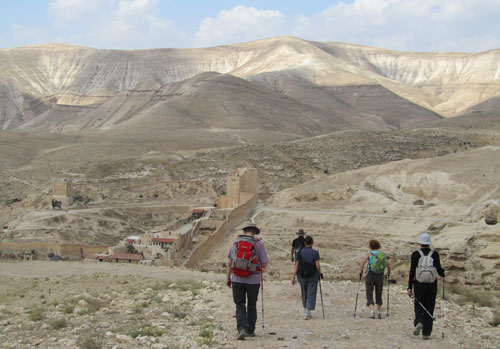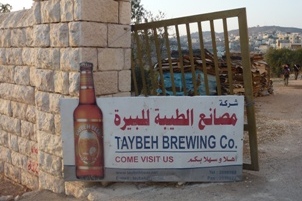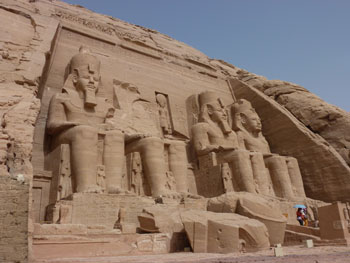Contrasts of Israel
Israel is not an obvious destination for adventure travellers. A combination of regional instability and conflict and the impression of a country that’s more likely to attract coach loads of pilgrims than intrepid backpackers has left it low or off the list of most travellers. This impression is only reinforced when beginning a trip to the country from the UK. Journeys to more far flung destinations may involve long haul flights on the great world airlines in the company of an exotic assortment of fellow passengers. Travelling to Israel entails flying with the garish low budget airline EasyJet from its unremittingly grim hub at Luton Airport, with most of the seats of the plane filled with church groups off to do the New Testament circuit around Galilee and Jerusalem. It’s not a promising start to a trip, but stick with it – Israel is a surprising gem in adventure travel. On a recent trip to the country, it was two very contrasting destinations that demonstrated to me what the country has to offer – the rich history and culture of the old city of Jerusalem and the vast, empty spaces of the Makhtesh Ramon in the Negev Desert.
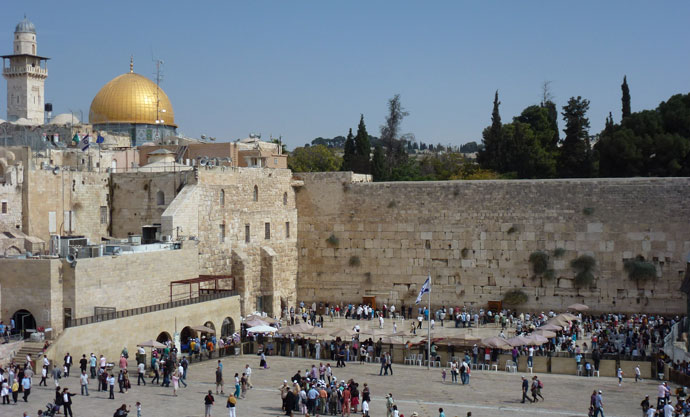
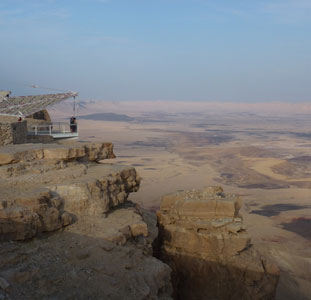
Why should a backpacker or independent traveller consider going to Israel? The ongoing conflict and political impasse between Israel and the Palestinian Authority continues to blight the country’s image from both a political perspective as well as for those considering travelling to the country. Most people will have an opinion on the conflict from one perspective or another, usually a strongly held one, but it’s only by travelling to the country and talking to the people on the ground that you can begin to understand the issues involved and see how history and faith informs the current situation. And while the modern political borders may be disputed, the cultural and historical heritage of Israel is the shared legacy of humanity.
Setting aside the political and security situation, Israel has a lot to offer the independent traveller. This tiny country punches well above its weight when it comes to attractions for visitors. Like its neighbours, it has been at the crossroads of civilisations for millennia, endowing it with an impressive historical legacy. While it may lack a standout wonder such as Petra in Jordan or Egypt’s Pyramids, in the Old City of Jerusalem Israel has one of the great travel destinations, for secular and religious alike. The country’s natural features are hugely diverse, from Mediterranean and Red Sea beaches, to the extreme heat and aridity of the Negev Desert, to the unique experience of floating effortlessly in the ultra saline Dead Sea. The country’s size and well developed transport infrastructure of trains and buses also allows visitors to easily travel between all the regions of interest, allowing you to customise and change any itinerary that suits your travel plans.
Into the Negev
The great Negev Desert, which covers nearly half of the country, stretches from the centre of Israel to its narrow coast at the Red Sea. David Ben Gurion, Israel’s first prime minister, thought this region the future of the country, with its development and inhabitation crucial for Israel’s prosperity. His dreams certainly haven’t been fully realised and the Negev retains a frontier feel, both for Israel’s citizens and for travellers. Many visitors to Israel will ignore this region completely or bypass it quickly on the way to the tacky beach resort town of Eilat on the Red Sea. Those that do stop will be rewarded with striking natural features, historical sites like the Nabataean towns of the old incense route and the even more ancient pre-historic biblical tells, as well as some fascinating towns and settlements.
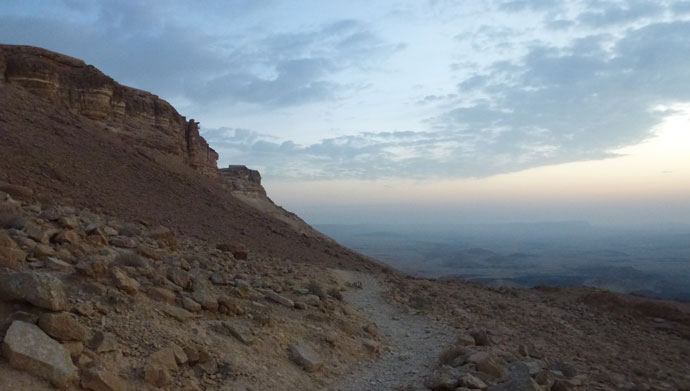
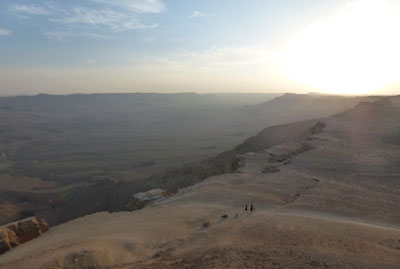
After a weekend enjoying the Bauhaus heritage and great restaurants, bars and boutique hotels of Tel Aviv, I headed south into the desert. My destination was the small oasis town of Mitzpe Ramon, a modern but sleepy settlement located almost exactly in the middle of the Negev. The bus trip south, via the city of Beer Sheba, was a reminder of the region’s political situation – the bus was packed with young people on national service, many armed, returning to the army bases of the Negev after weekend breaks. Mitzpe Ramon is spectacularly located on the edge of the Makhtesh Ramon. Mahkteshs are large asymmetrical craters formed by erosion by the transition from ocean to desert, a phenomenon unique to the Negev and Sinai. The Ramon is the largest at an amazing 40km long, 8km wide and up to 300 metres deep, a stunning spectacle with multi-coloured sandstone, volcanic rock and fossils.
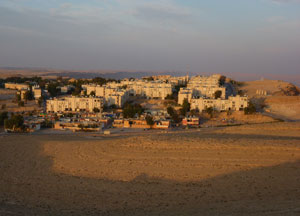
After arriving in town, I made my way to the Green Backpackers where I was staying for two nights. The Green is the quintessential small and homely hostel, like being invited to stay in someone’s house, a great base for relaxation or exploration. At the other end of the scale was the 5 star exclusive Beresheet, guarded like a secret government facility, though their chalet rooms with infinity pools overlooking the Makhtesh were somewhat spoiled by the public footpath between them and the crater’s edge! As the heat of the day abated, I explored the town, taking in the great views from the cliff-top promenade and the gorgeous sunset from Camel Hill before dinner at the town’s only bar. It was to be an early night however, to wake up pre-dawn for a trek into the makhtesh.

An early start is essential to avoid the intense midday desert heat, certainly for a northern European like me for whom 20°C is considered hot. Nothing stirred in the town as I made my way to the edge of the makhtesh in the morning darkness. I waited for the sky to brighten a little to enable me to see the trail, then headed down into the vast crater. For the next few hours, I explored the spectacular landscapes of the makhtesh as the sun rose and revealed the ever changing colours of the rock faces. It was a magical experience, all the more so for not seeing a single other person on the whole trail before hitching a ride back into town from the highway.
There are many other hiking trails a short drive from Mitzpe and the options of jeep tours, horse riding and visiting a local alpaca farm, though a combination of lack of time and the stifling midday heat kept my activities to a minimum. I did however get the chance to experience nightlife Mitzpe-style - an astronomy evening with Ira Machefsky, the “starman of Mitzpe Ramon”, and one of the great characters of the town. This is one of the most unique activities in town and Ira takes advantage of the clear desert skies to introduce the planets and constellations with some powerful, portable telescopes, a highly recommended tour. Mitzpe and the Negev proved to be an unexpected highlight of my trip to Israel – next on the agenda was the complete contrast of the ancient and crowded old city of Jerusalem.
The Holy City
Jerusalem is of course one of Israel’s major attractions, one of the world’s most ancient, revered, contested and captivating cities. The site of some of the holiest sites for the three great Abrahamic religions of the world – Judaism, Christianity and Islam, Jerusalem has been attracting visitors, both religious and secular, for centuries. Being fought over and conquered by Babylonians, Persians, Romans, Arabs, Crusaders, Ottomans to name just a few (conflict that continues today between Israelis and Palestinians and Arabs) has left the city with a troubled soul but an enormously rich historical legacy and every inch of the old city seems to tell the story of millennia of struggle and achievement. It would take weeks of exploration to do justice to Jerusalem, but with only days you can still appreciate what has been beguiling visitors for centuries.

The old city remains Jerusalem’s main draw, its narrow alleyways and ancient buildings begging to be explored. One of the most interesting aspects is the stark contrast between the four quarters of the old city (Christian, Muslim, Jewish and Armenian) and also between the three major holy sites. The Christian Quarter seems lined with endless souvenir shops trying to attract the custom of the continuous stream of tour groups filing through the Via Dolorosa and other narrow alleyways. This is the part of Israel where the Holy Land tour groups and the independent adventure travellers collide and you won’t be going anywhere very quickly. Christianity’s holiest site, the Church of the Holy Sepulchre (right), is equally teeming with tourists and pilgrims alike, with the overlapping services of the various Christian denominations that reluctantly share the church adding to the intensity of the experience. The Muslim quarter is quite a contrast. Its streets are equally busy but this is more due to the bustle of the everyday lives of locals rather than tourists, revealing the old city as the living, thriving town it has been for centuries. However ascending to the Temple Mount or Al-Haram ash-Sharif, site of the Dome of the Rock (below) and the Al-Asqa Mosque, you can escape the crowds of the old city and appreciate some of Islam’s holiest sites in peaceful tranquility, though both structures are off limits to non-Muslims.
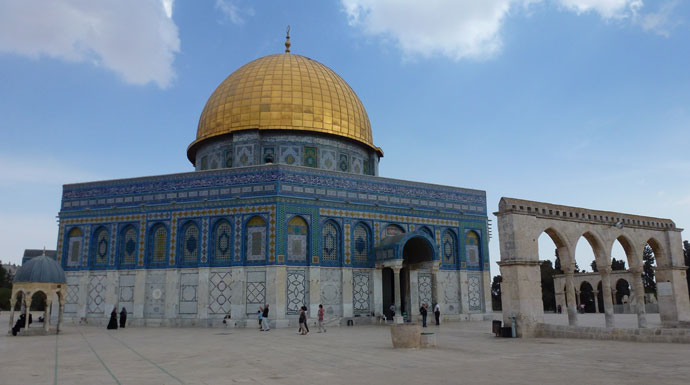
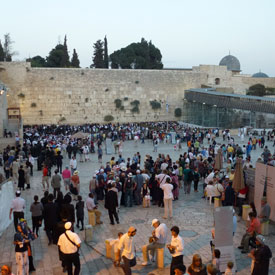
The Jewish quarter is just as different and distinctive again. Much of this area and its historical buildings and synagogues were destroyed after the old city was captured by the Jordanians in 1948. Today rebuilt, it is the most modern part of the old town, a mostly quiet and residential area. At its heart of course is the Western Wall and its adjoining broad plaza (left), the only remains of the Second Temple and Judaism’s holiest site. Contrary to the widespread perception of the Wall as a place for bemoaning the loss of the Temple (the “Wailing Wall” of popular myth), the plaza is the vibrant centre of Jewish cultural and spiritual life in Jerusalem. At sunset on Shabbat and for special ceremonies like Bar Mitzvahs, the plaza is awash with music, singing and dancing, an extraordinary and surprisingly vivacious atmosphere at one of Israel’s oldest and most religious sites.
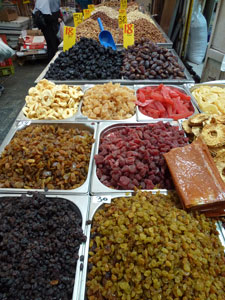
The major holy sites of course only begin to tell the tale of this timeless city and there is enough to keep you occupied in Jerusalem for as long as your budget and feet can stretch. For small fees, two other historical sites in the old city are especially recommended - the Citadel or Tower of David is the well preserved traditional centre of power in the city and offers great views of the city skyline as well as a concisely presented display of Jerusalem’s history. The Western Wall tunnels take you underground and back in time to explore the enormous foundation stones of the Temple Mount (this tour must be booked online in advance). Places of interest in the modern, new city are far more dispersed and range from the superb Israel Museum (home to the Dead Sea Scrolls) to the colourful Mahane Yehuda market (right) with its wonderful collections of local produce. And while Jerusalem certainly doesn’t have the cafe culture or nightlife of Tel Aviv, but the compact region of bars and restaurants along Jaffa Road is a great spot to relax weary legs after a long day’s sightseeing.
Being centrally located and the centre of Israel’s tourist industry, Jerusalem is a great base for taking day tours to other parts of the country if you are short of time (and almost inevitably you will be). The fantastic Abraham Hostel where I was staying has numerous tours to help you explore the city and beyond (once more the contrast between Jerusalem and Mitzpe was striking, the Abraham being a huge and packed hostel, though at least similar to the Green Backpackers in the friendliness and efficiency of the staff). Particularly recommended is their Best of the West Bank day tour, a fascinating insight into past and present of this troubled land which includes Bethlehem, Jericho and the fantastic Taybeh Brewery!. Dead Sea trips are also a must for the obligatory floating in the saline waters and mud manicure – tourist cliché but great fun, which is combined with visits to the remarkable mountain top Herodian fortress at Masada and a hike to the beautiful waterfalls at the Ein Gedi oasis. Trips to the historic and religious sites around the northern Mediterranean coast and Sea of Galilee are also possible.
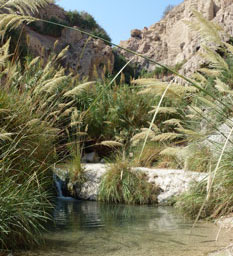
Ein Gedi Oasis
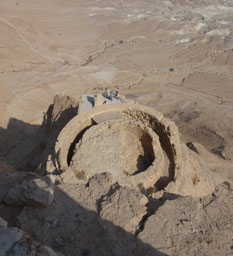
Masada Fortress
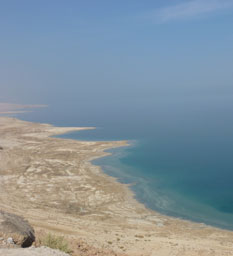
Dead Sea
Long before backpackers first set out on the hippie trail to Central Asia in the 1960s, before travellers embarked on the Grand Tour through Europe and the Middle East in the 18th and 19th centuries, Israel and the Holy Land was the original travel destination for Western Europeans during the Middle Ages. Travellers departed on long and arduous journeys over land and sea on pilgrimages to Jerusalem and other biblical sites, often succumbing to disease and attacks by hostile forces. Today, Israel is still a great destination for adventure travellers and while flying there with Easyjet may lack the exotic adventure of travel in centuries past, at least it offers a much safer, quicker and cheaper way of getting to a fascinating land. The old city of Jerusalem is still drawing huge crowds after all these centuries, while the far more ancient Makhtesh Ramon and the Negev Desert is attracting new travellers and demonstrating the diversity this small country has to offer.
For more information on travel to Israel including details of other travel highlights, see our country guide.
Related articles:
|
Warm welcomes, beautiful landscapes and surprising diversity on a new Wild Frontiers walking trip in the historic land of Palestine |
Exploring the rock-carved city of Petra, one of the greatest travel destinations in the world, 200 years since its rediscovery. |
|
A visit to the West Bank's only brewery in Taybeh near Ramallah, producing the best beer in the Middle East. |
There's never been a better time to explore the wonders of ancient Egypt on a trip along the Nile Valley |
Submit a comment on this article



